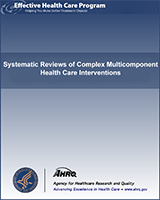NCBI Bookshelf. A service of the National Library of Medicine, National Institutes of Health.
Guise JM, Chang C, Viswanathan M, et al. Systematic Reviews of Complex Multicomponent Health Care Interventions [Internet]. Rockville (MD): Agency for Healthcare Research and Quality (US); 2014 Mar.

Systematic Reviews of Complex Multicomponent Health Care Interventions [Internet].
Show detailsTable 3Key informant recommendations for reporting elements in primary research of complex multicomponent interventions
| Reporting Category | Description of Recommended Element | Similarities With Existing Reporting Criteria |
|---|---|---|
| Population | Who is targeted (intended recipient) by the intervention Individual Population Health systems | CONSORT targeted recipients |
| Characteristics of Participants Behaviors Skill level required to participate in intervention Ethnicity Language Gender Age Risk status High risk - describe medical and social complexity | CONSORT intervention recipient SQUIRE-plan for intervention implementation, by whom (item 9c) | |
| Intervention | Components Explicitly state active and optional components A priori and final components Number of components Degree to which components are independent vs. interact Variability within and between components | CONSORT elements CReDECI-description of intervention components (item 2); rationale for selection of components (item 3); illustration of intended interactions between components (item 4); rationale for aim/essential function of components (item 5); description of unexpected interactions between components and environment (item 15) SQUIRE-describe intervention and components (item 9a) |
| Fidelity and degree of adaptability and tailoring Describe what tailoring is done | CONSORT tailoring CReDECI-description of any deviation from the study protocol (item 13) | |
| Intervention | Theoretical foundation for intervention Logic Model and/or Conceptual Flow Diagram How the intervention is thought to work | CReDECI description of underlying theoretical considerations (item 1) CReDECI-illustration of any intended interactions between components (item 4) SQUIRE-mechanism by which intervention components were expected to cause change (item 10b) |
| Replicability of intervention Theoretical basis Evidence of replicability Provide sufficient detail for others to replicate | CONSORT tailoring CReDECI-description of materials used for implementation to allow a replication (item 11) | |
| Incentives | CONSORT intervention incentives | |
| Governance issues | Not Addressed | |
| Characteristics of agents delivering the intervention Skill set Behaviors Profession (lay people, MD, RN, etc.) Amount of training required to deliver intervention General content, frequency, intensity | CONSORT provider | |
| Intensity of Intervention | CONSORT intensity | |
| Frequency of Intervention | ||
| Duration of Intervention | CONSORT duration | |
| Cost of intervention | Could be covered by CReDECI-description of cost or required resources for the intervention's implementation (item 16) SQUIRE-reviews issues of opportunity cost and actual financial cost (item17d). | |
| Comparator | What “usual care is” | CReDECI description of control or usual care (item 9) |
| Setting/Context | Organizational features Readiness to change Rogers stages of adoption Leadership at organizational level | Not specifically addressed though perhaps CONSORT setting; CReDECI-consideration of contextual factors and determinants of the setting in the modeling of the intervention (item 6) SQUIRE: elements of setting (item13ai) |
| Champions required Key attributes of champions, such as profession | CONSORT provider | |
| Rival activities | SQUIRE-reviews issues of opportunity cost and actual financial cost (item17d). | |
| Key contextual factors responsible for effect | CONSORT setting, CReDECI consideration of the contextual factors and determinants of the setting in the modeling of the intervention (item 6) | |
| Setting/Context | Geographic location | Not specifically addressed though perhaps CONSORT setting, CReDECI consideration of the contextual factors and determinants of the setting in the modeling of the intervention (item 6) |
| Financial Setting Fee for service Capitation Medicare/Medicaid Uninsured | Not specifically addressed though perhaps CONSORT setting, CReDECI consideration of the contextual factors and determinants of the setting in the modeling of the intervention (item 6) | |
| Clinical setting Private practice (solo or group) Public health Integrated health plan | CONSORT setting | |
| Outcomes/Evaluation of Effect | Expected effects | CReDECI rationale for the aim/essential functions of the intervention's components, including the evidence whether the components are appropriate for achieving this goal (item 5) |
| Negative findings need to be reported as well | May be addressed by SQUIRE-considers benefits/harms/unexpected results/problems/failures (item 13biii) | |
| Resource utilization | CReDECI-description of costs or required resources for implementation (item 16) SQUIRE-reviews issues of opportunity cost and actual financial cost (item17d) | |
| Evaluation criteria or evaluating effectiveness of intervention | CReDECI-description of an evaluation of the implementation process (item 12) | |
| Study Design Used | SQUIRE 10c |
- Table 3, Key informant recommendations for reporting elements in primary researc...Table 3, Key informant recommendations for reporting elements in primary research of complex multicomponent interventions - Systematic Reviews of Complex Multicomponent Health Care Interventions
Your browsing activity is empty.
Activity recording is turned off.
See more...